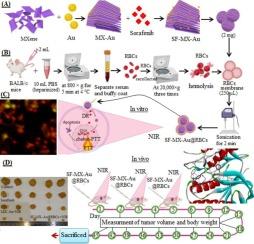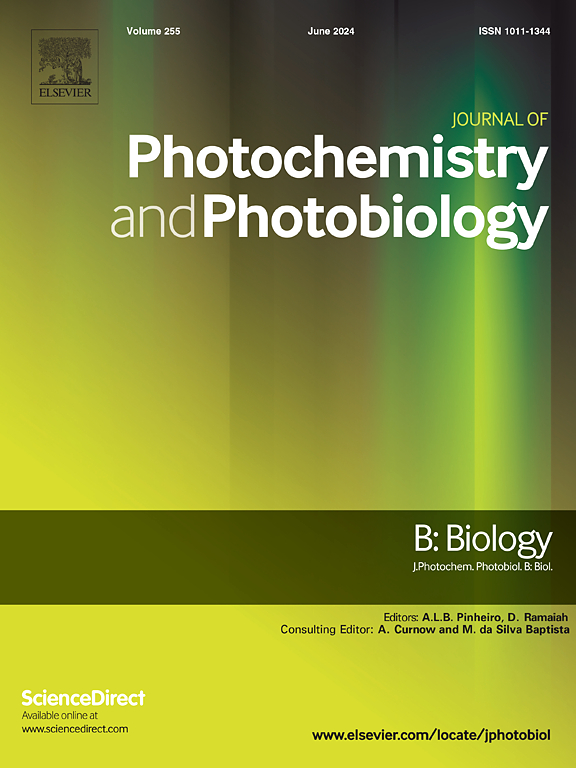红细胞膜包被索拉非尼- mxene - au纳米复合材料用于肝癌的协同化学光热治疗
IF 3.7
2区 生物学
Q2 BIOCHEMISTRY & MOLECULAR BIOLOGY
Journal of photochemistry and photobiology. B, Biology
Pub Date : 2025-05-27
DOI:10.1016/j.jphotobiol.2025.113185
引用次数: 0
摘要
红细胞(RBC)膜是一种新型的生物纳米载体。在这项研究中,红细胞膜包被索拉非尼(SF)-MXene-Au纳米复合材料(SF-MX-Au@RBCs)被开发为一种智能药物递送(SDD)系统,在近红外(NIR)照射下提供增强光热治疗(PTT)。合成的SF-MX-Au@RBCs平均尺寸约为65 nm, zeta电位为- 22.11 mV。在pH 7.4的近红外照射下,SF-MX-Au@RBCs在96小时内的累积SF释放量达到61.4%。此外,SF-MX-Au@RBCs作为化疗- ptt治疗对HepG2肝癌细胞的治疗效果进行了评估。体外实验显示出显著的细胞毒性,化学- ptt的IC50值为7.3 μg/mL,坏死率为31.9%,总凋亡率为56.3%(晚期凋亡29.5%,早期凋亡26.8%)。Western blot分析显示,MEK/ERK信号通路中磷酸化的ERK (p-ERK)和MEK (p-MEK)明显受到抑制,SF-MX-Au@RBCs组的抑制作用比SF组更大。此外,包括VEGFR2、VEGFR3和PDGFR在内的关键血管生成相关蛋白被下调,这凸显了纳米复合材料优越的抗血管生成作用。在近红外下使用BALB/c小鼠异种移植模型的体内研究显示,与其他治疗组相比,化疗- ptt治疗组的肿瘤体积(140 mm3)和肿瘤重量(0.16 g)最小。化疗- ptt方法显著增强了抗肿瘤疗效,突出了通过靶向药物输送系统(DDS)进一步优化和改善治疗结果的潜力。此外,我们还进行了全面的分子对接分析,研究了SF和MXene与RAF原癌基因丝氨酸/苏氨酸-蛋白激酶、FGR酪氨酸-蛋白激酶和丝裂原活化蛋白激酶(MAPK)三个关键蛋白的结合相互作用。MXene在所研究的靶蛋白上表现出优越的结合亲和性,其ΔG值范围为- 11.94至- 12.56 kcal/mol。本文章由计算机程序翻译,如有差异,请以英文原文为准。

RBC membrane-coated sorafenib-MXene-Au nanocomposites for synergistic chemo-photothermal therapy of liver cancer
Red blood cell (RBC) membrane has emerged as innovative biological nanocarriers. In this study, RBCs membrane-coated sorafenib (SF)-MXene-Au nanocomposite (SF-MX-Au@RBCs), was developed as a smart drug delivery (SDD) system, offering enhanced photothermal therapy (PTT) under near-infrared (NIR) irradiation. The synthesized SF-MX-Au@RBCs exhibited an average size of approximately 65 nm and a zeta potential of −22.11 mV. The cumulative SF release from SF-MX-Au@RBCs reached 61.4 % under NIR irradiation at pH 7.4 over 96 h. Furthermore, the treatment effectiveness of SF-MX-Au@RBCs as a chemo-PTT treatment was evaluated against HepG2 liver cancer cells. In vitro assay demonstrated significant cytotoxicity, with chemo-PTT achieving an IC50 value of 7.3 μg/mL and leading to necrosis rates of 31.9 % while the total apoptosis rates was 56.3 % (29.5 % late and 26.8 % early apoptosis) in treated cells. Western blot analysis indicated significant suppression of phosphorylated ERK (p-ERK) and MEK (p-MEK) in the MEK/ERK signaling pathway, with greater inhibition observed in the SF-MX-Au@RBCs group compared to SF alone. Additionally, key angiogenesis-related proteins, involving VEGFR2, VEGFR3, and PDGFR, were downregulated, highlighting the superior antiangiogenic effects of the nanocomposite. In vivo studies utilizing a xenograft model in BALB/c mice under NIR revealed that the chemo-PTT treatment indicated the smallest tumor volume (140 mm3) and tumor weight (0.16 g) compared to the other treatment groups. The chemo-PTT approach significantly enhanced antitumor efficacy, highlighting the potential for further optimization and improved treatment outcomes through targeted drug delivery systems (DDS). In addition, a comprehensive molecular docking analysis was conducted to examine the binding interactions of SF and MXene with three crucial proteins, namely: RAF proto-oncogene serine/threonine-protein kinase, FGR tyrosine-protein kinase, and mitogen-activated protein kinase (MAPK). MXene demonstrated superior binding affinities across the investigated target proteins, with ΔG values ranging from −11.94 to −12.56 kcal/mol.
求助全文
通过发布文献求助,成功后即可免费获取论文全文。
去求助
来源期刊
CiteScore
12.10
自引率
1.90%
发文量
161
审稿时长
37 days
期刊介绍:
The Journal of Photochemistry and Photobiology B: Biology provides a forum for the publication of papers relating to the various aspects of photobiology, as well as a means for communication in this multidisciplinary field.
The scope includes:
- Bioluminescence
- Chronobiology
- DNA repair
- Environmental photobiology
- Nanotechnology in photobiology
- Photocarcinogenesis
- Photochemistry of biomolecules
- Photodynamic therapy
- Photomedicine
- Photomorphogenesis
- Photomovement
- Photoreception
- Photosensitization
- Photosynthesis
- Phototechnology
- Spectroscopy of biological systems
- UV and visible radiation effects and vision.

 求助内容:
求助内容: 应助结果提醒方式:
应助结果提醒方式:


